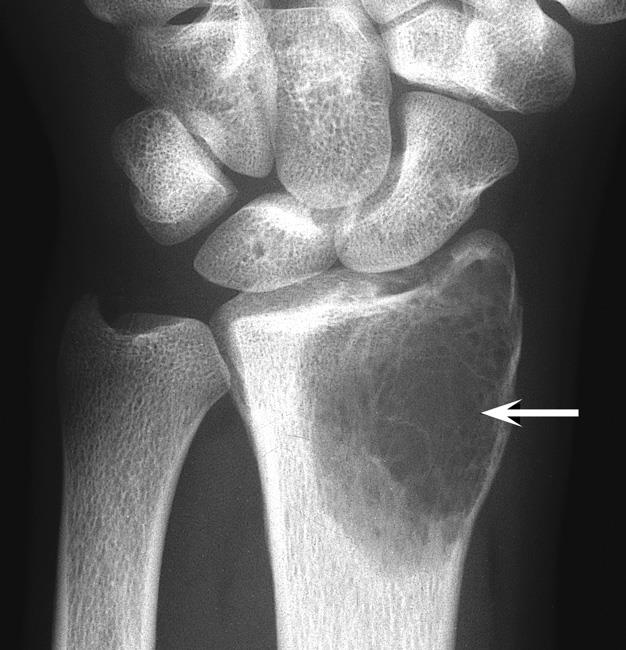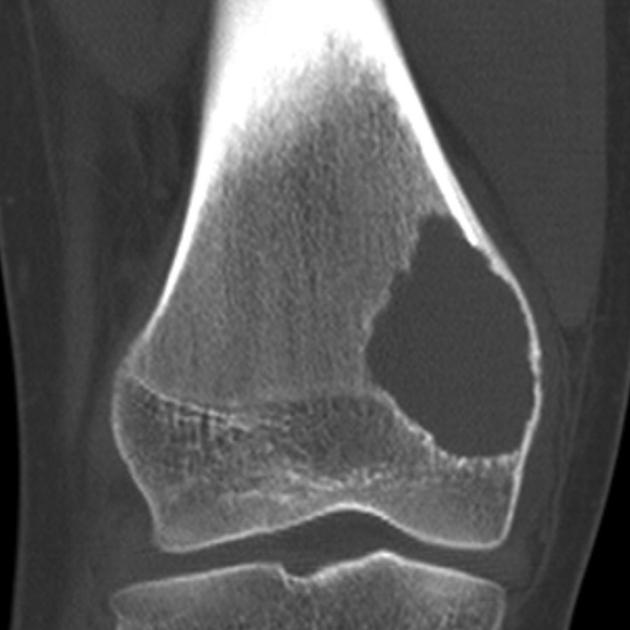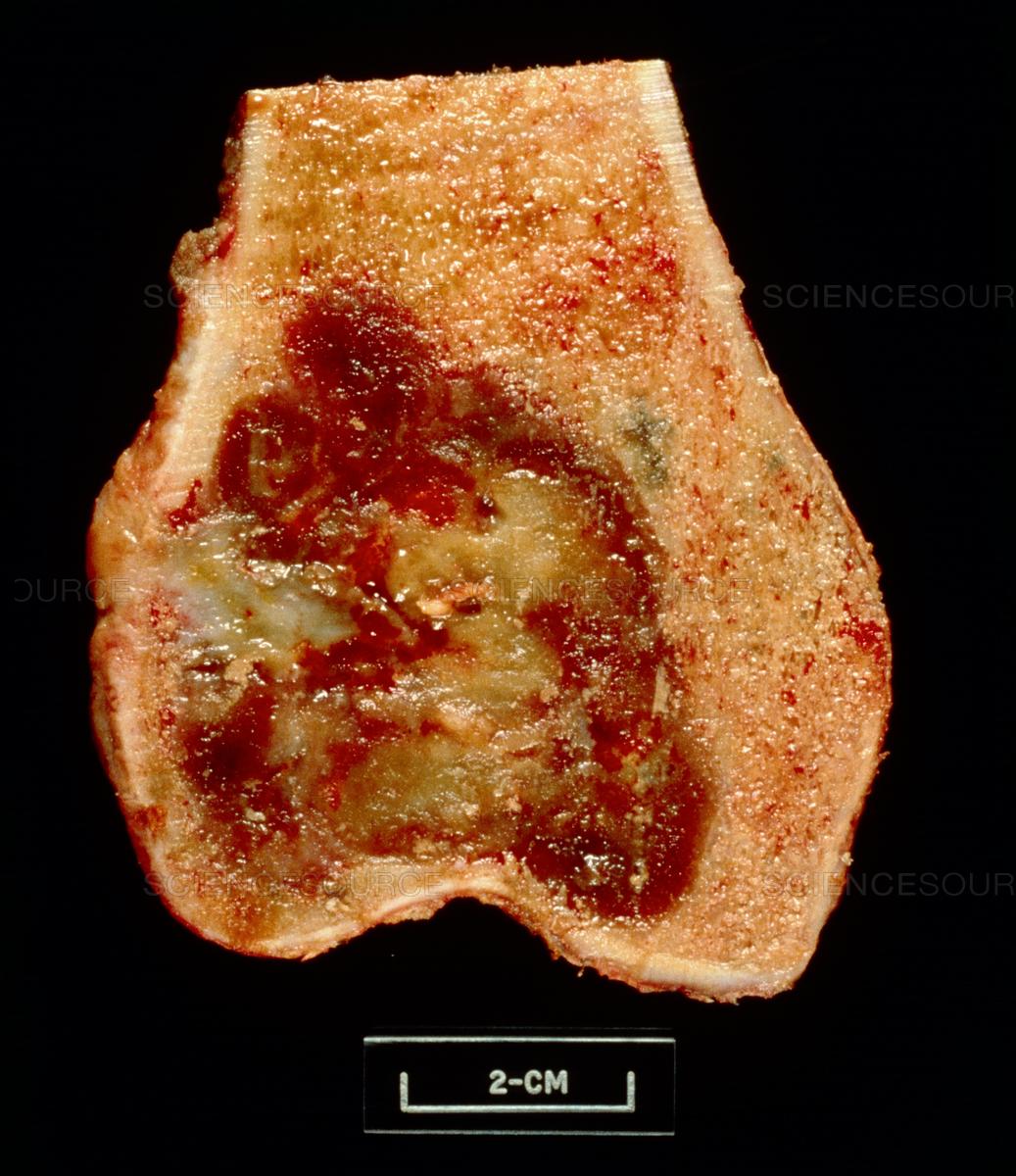Giant cell tumor of the bone.
A Giant cell tumor of bone is a form of benign or noncancerous) a tumor that affects and grows at the body’s long bone ends. Usually, these tumors develop at the upper end of the tibia (shinbone), close to the knee joint, or at the lower end of the femur (thighbone).
Giant cell tumors are slightly more common in females and typically occur in young adults. They occur in only about one out of every one million people per year, thus are quite rare.
Although these tumors are not cancerous, they can destroy the surrounding bone and are quite aggressive. Treatment involves preventing damage to the bone near the affected joint by removing the tumor with the help of surgery.


What Causes Giant cell tumors?
What causes a giant cell tumor is still unknown. They occur spontaneously as it is clear that trauma, environmental factors, or diet is not responsible for it. These tumors are not inherited as well.
However, in rare cases, the tumors have been found to associate with “hyperparathyroidism” which means overactivity of the parathyroid glands.
What are the symptoms of Giant cell tumors?
There are several symptoms of this disease. Pain in the area of the tumor is the most common symptom of a giant cell tumor. As the person shows movement, pain develops in the nearby joint. With the increase in the activity, the pain usually increases while it decreases with rest.
The pain gets worse over time as the tumor increases in size but is usually mild at first. Occasionally, the bone can break because of a tumor which causes sudden onset of severe pain. Sometimes, the patient will notice a mass or swollen area instead and will have no pain at all. Accumulation of fluid may also occur in the joints near the affected area.
How your doctor will detect the tumor?
First, your doctor is going to perform a thorough physical examination and utilize x-rays and other tests to detect a giant cell tumor.
Tests
X-ray: You will get images of dense structures, such as bone with this test. An x-ray helps your doctor to confirm the diagnosis.
A giant cell tumor will appear as a destructive (lytic) lesion next to a joint on x-ray. Occasionally, a thin rim of white bone is present around the involved area of bone, which may be either incomplete or complete. The bone in the area may also show some expansion.
Other imaging techniques: Your doctor may also ask you to have a computerized tomography (CT) scan or a magnetic resonance imaging (MRI) scan to help better study the tumor and the surrounding area.
At the time of the initial diagnosis, a CT scan or chest x-ray is also helpful to see if the tumor has spread to the lungs.


Bone scan: A bone scan is also good in some cases. During this test, the injection of a very small amount of radioactive dye is given intravenously. These tumors appear as a “hot spot” at the place where the tumor is present when they uptake the radioactive material.


Biopsy: To confirm the diagnosis of a giant cell tumor, you may need a biopsy. In a biopsy, your doctor takes a sample of tissue from the tumor and examines it under a microscope.


Before the operation with a needle, your doctor will give you anesthesia locally.
Treatment
A giant cell tumor will continue to grow and destroy the surrounding bone without treatment, so treatment is very important. The motives for the treatment are:
Remove the tumor
Prevents damage to the bone
Surgery prevents the tumor from spreading to other parts, this is the preferred treatment for giant cell tumors. However, sometimes due to certain problems, your doctor may not be able to remove the tumor safely or effectively. At that time, your doctor recommends nonsurgical means.
Nonsurgical Treatment
Nonsurgical treatment includes:
Radiation: In case the surgery is difficult to perform, your doctor will recommend radiation therapy to shrink giant cell tumors without damaging sensitive tissues like the spine. Your doctor will recommend this in only certain cases, as it can result in the formation of cancer in some patients.
Tumor embolization: Blocking of the specific arteries that supply blood to the tumor is done during this procedure. The tumor cells begin to die without the supply of oxygen and nutrients. Embolization is most often good before surgery, but may also be performed on its own where surgery is not possible.
Medication: For the treatment of giant cell tumors, the FDA approves the use of an injectable medication. The medication targets a special receptor on the tumor cells and kills them. This way, it slows down the breakdown of bone and decreases its activity. In cases your doctor is not able to perform the surgery, then medications come into play.
Surgical Treatment
Surgery is quite useful for the effective treatment of giant cell tumors. It includes:


Curettage: Curettage is the surgical procedure to treat giant cell tumors and is most commonly used. Your doctor will use a special instrument to scrape the tumor out of the bone in this method.
Bone graft: Your doctor will fill your bone with a bone graft to help stabilize the bone after curettage to fill the cavity. A surgeon takes a bone graft from a donor (allograft) or another bone in your body (allograft). Your doctor will take this from your hip most often.
A cement mixture may also be of good use to fill the hole. Sometimes, to try to reduce the risk of recurrence, your doctor may also fill the bone cavity with some additional chemicals, such as liquid nitrogen, hydrogen peroxide, or phenol.


Other procedures: Your doctor will prefer more complex surgical removal and reconstruction if the tumor causes excessive damage.
Your doctor may try to restore the body part by using bone grafts, artificial joints, or a combination of these to reconstruct the bone, joint, or soft tissue sites. This helps a patient do his/her everyday normal activities.
Giant cell tumors may also affect the lungs in certain cases. Surgical removal often becomes necessary so that the patient cures completely.
Steps that you should take:
- Tips when you go to your doctor:
- Know why you are visiting and what you want from your doctor.
- Write down questions that you need an answer for.
- Remember, whatever your doctor tells you and take someone along to help you ask questions.
- Write down the names of new medicines, new diagnoses, new tests, or treatment options. Keep note of instructions that your doctor provides you.
- Ask how medicine helps you treat and how it helps. Try to know about side effects, if there are any.
- Ask if there are other ways to treat your tumor.
- Ask why a test is necessary and what its result means.
- Write down the time, date, and purpose of visits in the future.
- Ask your doctor about what if you miss taking the medicine?
- Ask for contact details. You can ask questions if you have one at home.
